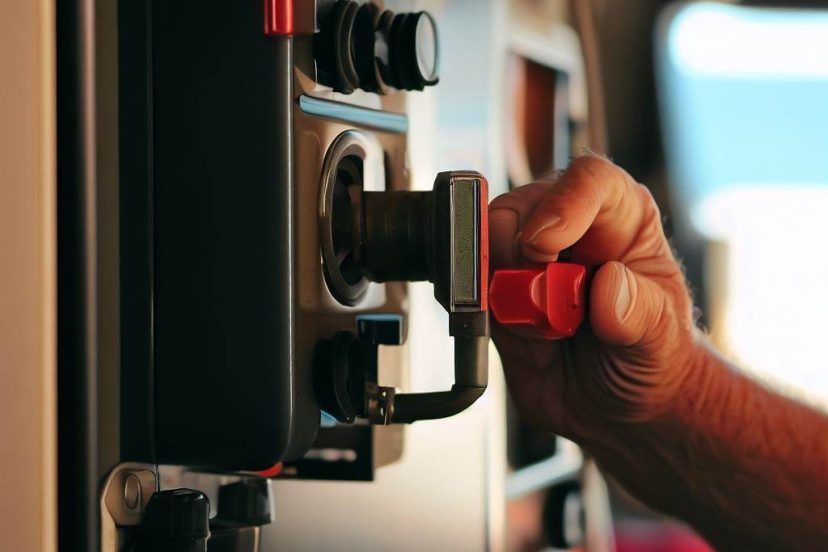Why You Need an RV Battery Disconnect Switch
As an avid RV enthusiast and advisor, I understand the importance of having a reliable RV battery disconnect switch. Regarding RV camping, various risks and challenges can arise, especially if you overlook the significance of a battery disconnect switch. In this article, I will delve into the world of RV battery disconnect switches, highlight their importance, discuss the risks of camping without one, and provide helpful suggestions to ensure a smooth and safe RV camping experience.
Understanding RV Battery Disconnect Switches
 Let’s begin by understanding what exactly an RV battery disconnect switch is. Essentially, it is a device that allows you to cut off the power flow between the battery and the electrical system of your RV. By using a disconnect switch, you can effectively isolate the battery, preventing it from draining and protecting your electrical system from potential issues.
Let’s begin by understanding what exactly an RV battery disconnect switch is. Essentially, it is a device that allows you to cut off the power flow between the battery and the electrical system of your RV. By using a disconnect switch, you can effectively isolate the battery, preventing it from draining and protecting your electrical system from potential issues.
Importance of RV Battery Disconnect Switches
Protecting the Battery from Drainage
One of the primary reasons why an RV battery disconnect switch is crucial is to protect your battery from unnecessary drainage. When your RV is not in use, various electrical components and devices can continue to draw power from the battery, even in standby mode. This is known as a parasitic drain and can significantly reduce the lifespan of your battery. By disconnecting the battery using a switch, you can eliminate this drain and ensure your battery remains fully charged and ready for use.
Ensuring Electrical Safety
Electrical safety is paramount when it comes to RV camping. Without a battery disconnect switch, there is a risk of accidental electrical shock or fires due to faulty wiring or equipment malfunctions. By installing a disconnect switch, you can easily cut off the power supply and minimize the chances of electrical accidents, ensuring the safety of yourself, your loved ones, and your RV.
Risks of RV Camping without a Battery Disconnect Switch
Now that we understand the importance of a battery disconnect switch let’s explore the risks associated with RV camping without one.
Draining the Battery
If you don’t have a battery disconnect switch, your RV’s battery is constantly connected to the electrical system. This means that even when your RV is not in use, certain devices and components can drain power from the battery, slowly depleting its charge. As a result, when you’re ready to hit the road again, you might find yourself with a dead battery, causing unnecessary delays and inconvenience.
Overloading the Electrical System
Without a disconnect switch, the electrical system of your RV remains active even when not in use. This means that devices and appliances continue to draw power, putting a strain on your electrical system. Over time, this can lead to overloading, which may cause electrical malfunctions, damage to appliances, and potential safety hazards.
Electrical Malfunctions and Safety Hazards
When your RV’s battery remains connected to the electrical system without a disconnect switch, there is a higher risk of electrical malfunctions. Faulty wiring, equipment failures, or power surges can lead to short circuits, fires, or other dangerous situations. By installing a battery disconnect switch, you can significantly reduce the risk of such malfunctions and ensure the overall safety of your RV.
Benefits of Installing an RV Battery Disconnect Switch
Now that we understand the risks of camping without a battery disconnect switch let’s explore the benefits of installing one.
Preserving Battery Life
One of the key advantages of a battery disconnect switch is that it helps preserve the life of your RV’s battery. Cutting off the power flow when not in use prevents unnecessary drain and extends the battery’s lifespan. This means fewer battery replacements and greater cost savings in the long run.
Preventing Parasitic Drain
As mentioned earlier, a parasitic drain is a common issue where certain devices and components draw power from the battery even when your RV is not in use. With a battery disconnect switch, you have full control over when the battery is connected or disconnected, effectively preventing any parasitic drain and ensuring your battery remains fully charged and ready for your next adventure.
Safeguarding Against Electrical Issues
Installing a battery disconnect switch adds an additional layer of protection to your RV’s electrical system. In case of electrical malfunctions or emergencies, you can quickly disconnect the battery to mitigate potential risks and prevent further damage. This provides peace of mind and ensures that you can address any electrical issues safely and carefully.
Types of RV Battery Disconnect Switches
When it comes to RV battery disconnect switches, there are several types available in the market. Let’s take a look at the most common ones:
Manual Disconnect Switches
Manual disconnect switches are the simplest and most straightforward type. They usually consist of a lever or a knob that physically disconnects the battery from the electrical system when turned off. Manual switches are reliable and cost-effective options for RV owners who prefer manual operation.
Remote-Controlled Disconnect Switches
Remote-controlled disconnect switches offer convenience and ease of use. They allow you to remotely disconnect or reconnect the battery using a wireless remote control. This type of switch is particularly useful if you want to control the battery status from inside your RV or from a distance.
Keyed Disconnect Switches
Keyed disconnect switches provide an added layer of security. These switches require a key to turn on or off, ensuring that only authorized individuals can access or disconnect the battery. Keyed switches are a popular choice for RV owners who prioritize security and want to prevent unauthorized use of their RV’s electrical system.
How to Choose the Right RV Battery Disconnect Switch
Now that we know the different types of RV battery disconnect switches available let’s discuss choosing the right one for your needs.
Consider Your Power Needs
Evaluate your power requirements and determine the size and capacity of the switch accordingly. If you have a larger RV with multiple electrical components, you may need a switch with a higher amp rating to handle the power demands effectively.
Compatibility with Your RV System
Ensure that your disconnect switch is compatible with your RV’s electrical system. Consider the voltage requirements, wiring configuration, and compatibility with your existing battery setup. It’s essential to select a switch that seamlessly integrates with your RV’s electrical infrastructure.
Quality and Reliability
Invest in a high-quality disconnect switch from a reputable manufacturer. Look for switches that are built to withstand the rigors of RV camping, are resistant to corrosion, and have reliable performance. Reading customer reviews and seeking recommendations can help you make an informed decision.
Installation Process of RV Battery Disconnect Switch
Installing a battery disconnect switch is a relatively straightforward process. Here’s a step-by-step guide to help you through the installation:
Step 1: Gathering the Necessary Tools and Equipment
Before you begin, gather the tools and equipment you’ll need for the installation. This may include a wrench or pliers, wire cutters/strippers, electrical tape, and a drill if necessary. Ensure that you have all the required components of the disconnect switch kit as well.
Step 2: Locating the Battery and Disconnecting Cables
Locate the battery compartment in your RV. Carefully disconnect the cables from the battery terminals, ensuring that you remember their respective positions for reconnection later. Use the appropriate tools to loosen the terminals and remove the cables.
Step 3: Installing the Disconnect Switch
Choose a suitable location for mounting the disconnect switch. It should be easily accessible yet protected from water and other elements. Follow the manufacturer’s instructions to mount the switch securely. Next, connect the battery cables to the switch, ensuring that they are tightened properly.
Step 4: Testing the Functionality
After the installation, test the functionality of the disconnect switch. Turn the switch on and off to ensure that the battery is connected and disconnected accordingly. Verify that all connections are secure and that the switch operates smoothly. If everything is functioning correctly, you’re ready to enjoy the benefits of your new RV battery disconnect switch.
Tips for Proper Maintenance of RV Battery Disconnect Switches
To ensure the longevity and optimal performance of your RV battery disconnect switch, follow these maintenance tips:
Regular Inspection and Cleaning
Periodically inspect the switch for any signs of damage, corrosion, or loose connections. Clean the switch and its components as necessary, using appropriate cleaning agents. Keeping the switch clean and well-maintained helps prevent issues and ensures its smooth operation.
Keeping Connections Tight and Secure
Regularly check the battery connections and the connections at the disconnect switch. Tighten any loose connections and ensure that all terminals are secure. Loose connections can cause electrical resistance, heat buildup, and potential malfunctions.
Battery Maintenance Practices
In addition to maintaining the disconnect switch, it’s essential to follow proper battery maintenance practices. Keep the battery clean, check its charge levels regularly, and ensure it is properly charged and maintained according to the manufacturer’s recommendations. This helps prolong battery life and ensures optimal performance.
Common Questions about RV Battery Disconnect Switches
Investing in an RV battery disconnect switch is a wise decision for any enthusiast conscious of their RV power. It protects your battery from drain, ensures electrical safety, and mitigates potential risks associated with RV camping. By choosing the right switch and following proper installation and maintenance practices, you can enjoy a hassle-free camping experience while preserving the lifespan of your battery and maintaining the safety of your electrical system.
Make sure to consider your power needs, compatibility with your RV system, and the quality of the switch before making a purchase. Install the switch correctly, follow the step-by-step instructions, and regularly inspect and maintain it to ensure optimal performance. With a battery disconnect switch in place, you can confidently embark on your RV adventures, knowing that your battery and electrical system are well-protected.
FAQs
Here are some frequently asked questions about RV battery disconnect switches:
Can I install a battery disconnect switch myself?
Yes, many RV owners install battery disconnect switches themselves. However, if you’re unsure or uncomfortable with electrical work, it’s best to consult a professional or seek assistance to ensure a proper installation.
Do I need a disconnect switch for both the chassis and house batteries?
It is recommended to have a disconnect switch for both the chassis and house batteries. This allows you to isolate each battery when not in use, preventing drain and ensuring the longevity of both batteries.
Will a disconnect switch completely cut off power to my RV?
A disconnect switch will cut off power flow between the battery and the electrical system, significantly reducing drain. However, some devices, such as carbon monoxide detectors or alarms, may still draw power from other sources in your RV.
Can I use a regular car battery disconnect switch for my RV?
While it may be tempting to use a car battery disconnect switch, it is not recommended. RV battery disconnect switches are specifically designed to handle the unique electrical requirements and conditions of RVs. It’s best to choose a switch specifically made for RV use.
Are there any alternatives to a battery disconnect switch?
While a battery disconnect switch is the most effective solution, some RVs may have built-in battery isolation systems. These systems function similarly to disconnect switches and provide a convenient alternative. Consult your RV’s manual or an expert to determine if your RV has this feature.





